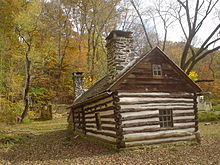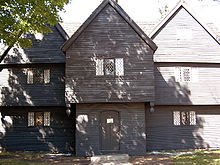

American colonial architecture includes several building design styles associated with the colonial period of the United States, including First Period English (late-medieval), Spanish Colonial, French Colonial, Dutch Colonial, and Georgian.[1] These styles are associated with the houses, churches and government buildings of the period from about 1600 through the 19th century.
Several relatively distinct regional styles of colonial architecture are recognized in the United States. Building styles in the 13 colonies were influenced by techniques and styles from England, as well as traditions brought by settlers from other parts of Europe. In New England, 17th-century colonial houses were built primarily from wood, following styles found in the southeastern counties of England. Saltbox style homes and Cape Cod style homes were some of the simplest of homes constructed in the New England colonies. The Saltbox homes known for their steep roof among the back the house made for easy construction among colonists.[2] The Cape Cod style homes were a common home in the early 17th of New England colonists, these homes featured a simple, rectangular shape commonly used by colonists.[3] Dutch Colonial structures, built primarily in the Hudson River Valley, Long Island, and northern New Jersey, reflected construction styles from Holland and Flanders and used stone and brick more extensively than buildings in New England. In Maryland, Virginia, and the Carolinas, a style called "Southern Colonial" is recognized, characterized by the hall and parlor and central-passage house types, which often had large chimneys projecting from the gable-ends of the house. In the Delaware Valley, Swedish colonial settlers introduced the log cabin to America. A style sometimes called Pennsylvania colonial appeared later (after 1681) and incorporates Georgian architectural influences. A Pennsylvania Dutch style is recognized in parts of southeastern Pennsylvania that were settled by German immigrants in the 18th century.[4]
Early buildings in some other areas of the United States reflect the architectural traditions of the colonial powers that controlled these regions. The architectural style of Louisiana is identified as French colonial, while the Spanish colonial style evokes Renaissance and Baroque styles of Spain and Mexico; in the United States it is found in Florida, Louisiana, New Mexico, Texas, Arizona, and California.[4]
- ^ Colonial House Styles and Examples, OldHouses.com website (Copley Internet Systems, Inc.), accessed October 24, 2009
- ^ "Saltbox Houses in the Historic American Buildings Survey - Guides, Reference Aids, and Finding Aids (Prints and Photographs ReadingRoom, Library of Congress)". www.loc.gov. Retrieved 2017-12-05.
- ^ "Cape Cod Houses Recorded by the Historic American Buildings Survey (Prints and Photographs Reading Room, Library of Congress)". www.loc.gov. Retrieved 2017-12-05.
- ^ a b Colonial architecture in North America, Encyclopædia Britannica Online, accessed October 23, 2009